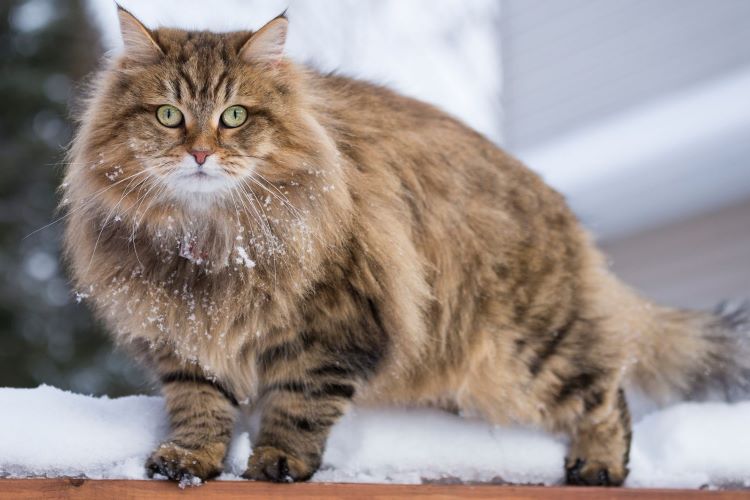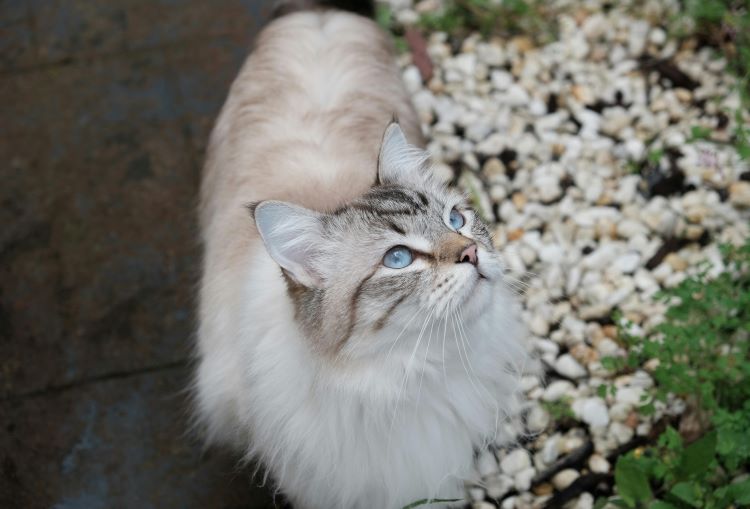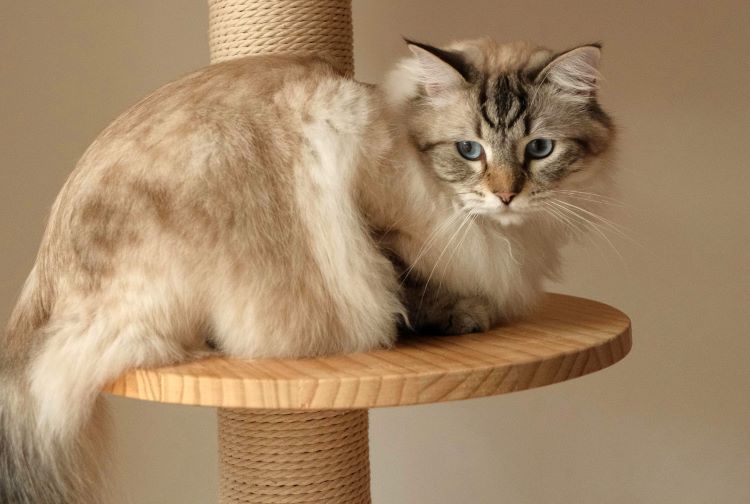Ready to help treat your pet to a healthy life?
Siberian Cat Breed: Fun Facts, History & Health
By : Brianna Gunter & Trupanion Staff | Published Jun 5, 2025

Floofy. Muscular. Majestic. These are all words commonly used to describe Siberian cats. Not to be confused with the Siberian tiger, these awesome kitties are said to be among the world’s oldest domestic cat breeds and are beloved for their luxurious, well-insulated coats. But is one of them the right feline pet for you?
Whether you’re hoping to learn more about Siberians as a prospective pet, want to discover more about your own cat’s rich history, or are just curious about felines in general, this guide to the Siberian cat breed has you covered.
What exactly is a Siberian cat?
Siberians are occasionally confused with Maine Coons because they are both large domestic cats with long, thick coats. But while they may look similar, these are two separate cat breeds with their own physical characteristics and history. Whereas the Maine Coon comes from North America, the Siberian originated in Russia. And although they're both large in build, the Siberian has a softer, sweeter face.
According to breed standards set by the Cat Fanciers’ Association (CFA) and The International Cat Association (TICA), these cats come in all colors and are largely defined by round features. They have large, rounded feet that often come with tufts of fur between the toes. They have a thick, rounded body covered in dense, medium to long fur. They also have wedged heads with rounded muzzles, topped with wide, rounded ears. In other words, Siberians are the perfect shape for cuddling!
8 fun facts
- The formal name of this breed is the “Siberian Forest Cat,” though the shortened form is much more commonly used.
- They are also sometimes called the “Moscow Semi-longhair” or simple, “Moscow Longhair.”
- Siberians are often referred to as hypoallergenic cats, thanks to many of them producing less of the Fel d1 allergen.
- They are a landrace cat breed, which means they were not specifically developed by humans but instead evolved naturally over time, adapting to their surroundings.
- Though they’re not the largest domestic felines, Siberians are pretty big, often reaching between 15 and 20 lbs (6.8 to 9 kg).
- These cats are known for being friendly and devoted to their humans, to the point that they’ll often greet their owners at the door.
- While Siberians come in just about every color and coat pattern, the most common you’ll see is a brown tabby with shades of gray, black, and/or white.
- The colorpoint variant or “sister breed” of the Siberian, called the Neva Masquerade, is often considered to be genetically the same cat but categorized as a separate breed by some cat registries.
History of the Siberian cat breed
Siberian cats are native to Russia, though like many centuries-old cat breeds, their exact origins are unknown. With their dense fur coats serving as protection from the winter cold, they are believed to have inhabited the forests of Siberia for many years before adapting to life alongside humans. Both the CFA and TICA note that the earliest known reference to the Siberian is from around 1,000 AD, but it’s unclear what this reference was. Regardless, these cats served multiple roles in their early days as pets. They were skilled mousers in rural communities but were also prized family cats among Russian families of all classes.
First global introduction
Nobody knows when the Siberian first made its way outside of Russia. However, written documentation suggests the Siberian cat was first mentioned elsewhere in the 1864 edition of the German book Brehms Tierleben, where they were descripted as “a red Tobolsk cat from Siberia.”
Later in 1889 and 1892, the Siberian earned mentions by famed cat fancier Harrison Weir. In these two editions of his book on cat breeds, he described the Siberian as the “Russian Long-haired Cat.” It’s believed that these Siberians who made their way around Europe and elsewhere eventually mixed in with other cat populations and were eventually lost.
Arrival to North America and official breed recognition
During the late 1980s, a new wave of Siberian cats were exported from Russia. The first group of Siberians were introduced to the United States by Louisiana-based cat breeder Elizabeth Terrell in 1990. Terrell helped grow the breed over the next decade, and its popularity grew. In 2000, the first Siberian entered the Cat Fanciers Association in the “miscellaneous class,” eventually reaching full recognition in 2006. Since then, Siberians have been recognized as an official cat breed by all major feline registries around the world.

Common questions about Siberian cats
Considering adopting a Siberian cat? Here are answers to some common questions about these beautiful felines.
1. Are Siberian cats hypoallergenic?
As noted earlier, Siberian cats are often considered to be hypoallergenic. While no cat is truly hypoallergenic, Siberians are one breed that’s often better tolerated by allergy sufferers. This is because studies have shown that many Siberian cats produce lower levels of Fel d 1 than other breeds. However, the levels of this allergen can vary greatly between Siberians. Basically, there’s no genetic guarantee that these cats will be low in allergens, but they are a better bet than many other cat breeds. So, if you are an allergy sufferer, it’s a good idea to try to meet prospective pets before adoption to gauge your reaction to them.
2. How much do Siberian cats cost?
Though not one of the most expensive cat breeds around, Siberians can still cost a pretty penny. Looking at listings from TICA-registered breeders as well as average shelter adoption costs, the cost of a Siberian cat can run anywhere from $1,000 to $4,000 from a reputable breeder or $50 to $250 when adopting from a shelter or rescue.
3. Are Siberians the same as Norwegian Forest Cats?
No! Despite these being two separate breeds, many people continue to mistake Siberians for Norwegian Forest Cats (along with Maine Coons and other large, longer-haired kitties). This is understandable, as the two have some similar features and Siberians are also sometimes called Siberian Forest Cats. The two may also share a common ancestor, though much is unknown about the early origins of both breeds. Rest assured though, they are two separate cat breeds today.
4. How sociable are Siberian cats?
Siberians are known for being highly sociable pets, often seeking out affection and attention from their humans. They tend to get along well with people of all ages, including small children (though supervision is still required). And, with proper introductions, these cats are also known to do well with other pets in the home.
5. How long do Siberian cats live?
On average, Siberians live between 10 and 18 years, with some living into their 20s. Nevertheless, a lot of factors go into how long a cat lives — genetics, lifestyle, and veterinary care are the three big ones.
While you can’t control your Siberian’s exact genetics (although adopting from a reputable breeder can help), you can do a lot of things to help promote their health. In addition to feeding your pet a healthy diet and keeping up with veterinary care, you can sign up for pet health insurance to help pay for surprise health conditions.
6. Do Siberians make good pets?
As many cat owners can attest, Siberians tend to make excellent pets! Their naturally friendly demeanors and cuddliness can be instant draws, and their willingness to get along with other pets and children can make them great additions to all kinds of households.
Of course, it is important to realize that cats are still individuals with their own personalities — two cats of the same breed can still wind up being very different. As you would with any new pet, give Siberians time to adapt and be patient with them.
Similar cat breeds to consider
- Norwegian Forest Cat
- Maine Coon
- Persian
- Exotic Longhair
- Ragdoll
- Himalayan

Breed care tips
Siberian cats are a relatively low-maintenance breed. Since they’re naturally playful, it should be easy to help your Siberian meet their daily exercise needs (and, yes, all cats need daily exercise despite their love of snoozing!). And, because these cats are so sociable, consider providing multiple cozy areas around the home for them to hang out near you in, along with toys to help keep them occupied.
Grooming needs
You’d think with all their fluffy fur, Siberians would require a ton of grooming. But despite their thick coat, these cats don’t tend to mat or tangle easily. This is because their fur is straight and consists of three layers rather than one big, dense, coarse coat. You should still brush them a couple times a week for good measure, doing so more often during seasonal shedding (spring and fall).
It’s also a good idea to trim your Siberian’s nails every two to three weeks to prevent overgrowth and scratching damage. If your cat doesn’t tolerate nail trimming at home well, consider bringing them to a professional groomer.
Common health issues in Siberians
As a naturally-developed cat breed with ancient origins, the Siberian is considered to be healthy overall. In fact, these cats have been shown to have one of the highest levels of genetic variation (heterozygosity) among all established cat breeds. Even so, all cats are at risk of surprise health conditions. Some health conditions that Siberians may be predisposed to include:
- Hypertropic cardiomyopathy (HCM) — a thickening of the heart muscle that could result in heart failure.
- Polycystic kidney disease (PKD) — an inherited condition that causes cysts to form on the kidneys.
- Feline lower urinary tract disease (FLUTD) — a generalized term for a series of conditions affecting a cat’s urinary tract.
- Gum disease — ranging from gum recession to inflammation, gum disease in Siberians can be prevented with regular dental health care.
To keep your cat healthy, it’s important to keep up with routine veterinary care visits and agree to health screenings (like those for HCM) as recommended. Ask your veterinarian for specific care tips for Siberians and longer-haired cats in general. Additionally, one of the best things you can do as a cat owner (of any breed) is to protect your pet early on with cat insurance.
